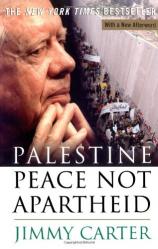Palestine: Peace Not Apartheid
Review
Palestine: Peace Not Apartheid
There are no photographs among the pages of PALESTINE: PEACE NOT
APARTHEID. You can't skim through Jimmy Carter's clear, concisely
crafted prose about the festering sore of a land some still call
holy and see the former 39th American president poised at hopeful
moments in history with a Who's Who of Middle Eastern politicians.
In fact, such photos would have been blatant lies.
Carter's book is not about posturing, posing, name-dropping or
appearances for the media, but looks instead behind the scenes at
scores of characters --- perpetrators, victims, brokers,
provocateurs, altruists, diplomats, tyrants, mediators, exploiters
--- whose tangled agendas have resulted in decades' worth of
grinding, thankless hard work with no apparent end in sight.
Instead of pictures, PALESTINE: PEACE NOT APARTHEID is eloquently
illustrated by maps, whose ragged contours show the tortuous
history of this land up to the present day.
The most telling and sadly persistent map of all is the last,
entitled "Palestinians Surrounded 2006." On it, the eye can travel
over the roughly bean-shaped area of the West Bank and see the
devastation wreaked on a subjugated nation and culture, not over
centuries or decades, but in the historical nanosecond of events
since 2000.
Running distinctly inside the dotted line of the
officially accepted boundary between Palestinian and Israeli
territory is a crude solid black line, indicating vast completed
stretches of Israel's notorious Security Wall. It is this obscene
multibillion-dollar structure --- pictured on the book's dust
jacket up against the author's noticeably averted eyes --- that has
given rise to increasing international use of the apt adjective
"apartheid" to describe the overall policy of Israel's government
and military authorities toward the Palestinian people.
The Wall's black outline traces a drunken path that repeatedly
veers away from the Israel-West Bank border to bite even more
deeply into Palestinian land, lurching around illegal Israeli
settlements that never should have been built, but that remain
imprinted in their dozens like a stubborn rash on the page.
If one were to imaginatively zoom down into the mapped bird's-eye
view of this continuing conflictual disaster, the footprint of the
Wall would suddenly take on the true contours of human despair that
Carter describes in memorably uncompromising words. Its hideous
height and breadth separates an entire people from their collective
birthright; families from generations-old olive groves, orchards,
fields, homes and pastures; able men and women from meaningful
work; businesses from their markets; children from the hope of
education; the sick and injured from medical care; and relatives
from traditional familial contact.
And as if that isn't enough to evoke utter despair for any progress
toward peace-with-justice, another feature of Carter's final map is
a broad dark-shaded band that runs the length of the natural border
formed by the Jordan River and western shoreline of the Dead Sea.
It is called on the legend "Areas of Planned Israeli Settlement
Control" and creeps like a spreading cancer eastward, covering
about one-third of the entire West Bank area. Make no mistake;
Israel's idea of "control" is not the prevention of illegal
settlements, but their enabling and enforced protection.
In essence, every printed page of PALESTINE: PEACE NOT APARTHEID is
the story of its last map. It is a story whose individual events,
breakthroughs, disappointments, betrayals (of which there are many)
and one-on-one human encounters are made relentlessly absorbing in
Carter's modest yet firmly convinced timbre.
The pieces and pawns of this sordid game, in which Carter continues
to strive for substance over promise and justice over containment,
are carefully and accurately laid out with surprising
even-handedness. All sides are exposed in the harsh light of their
various virtues and vices, but with the overall caveat that those
with the greatest power must shoulder a proportionally greater
responsibility for rectifying a shameful chapter in human history.
Only then can the ongoing cycle of Israeli-Palestinian violence and
oppression be broken and the resulting pieces mended into something
far better for all who believe in this wounded land as their
rightful home.
Reviewed by Pauline Finch ([email protected]) on January 14, 2011
Palestine: Peace Not Apartheid
- Publication Date: September 18, 2007
- Paperback: 288 pages
- Publisher: Simon & Schuster
- ISBN-10: 0743285034
- ISBN-13: 9780743285032










